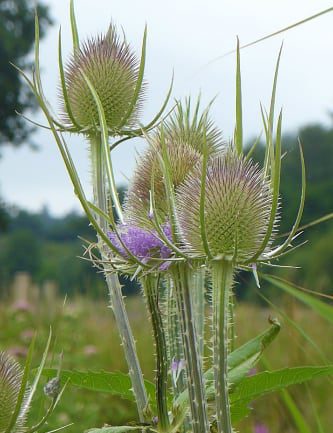Latin Name: Dipsacus fullonum
Common name: Wild Teasel
A favourite in dried flower displays, the Wild Teasel is an impressive, robust, tall biennial which can grow to 6 feet or more.
All parts of the plant have spines – leaves, stalks and egg-shaped flower heads.
They are found in rough grassland, stream banks and marginal habitats, thickets and hedgerows, also on roadsides and waste ground over a very wide range of soil types and are very common in the south of England.Teasel flowers are popular sources of pollen and nectar for bees and other insects. Teasel fruits prolifically and its persistent seed heads attract goldfinches, who are very partial to the seeds.
Because they seed freely they can spread even into lawns so it’s best to plant them in a corner where they can be contained.
They bloom in their second year and the best time to see them is during July and August when their striking purple colour really catches your eye.
An interesting fact is the teasel is so called because textile makers used its spiny combs to ‘tease’ cloth – cleaning it (carding) before spinning and raising the ‘nap’ or fuzzy surface. It wasn’t until the 20th century that they were replaced by metal combs.

